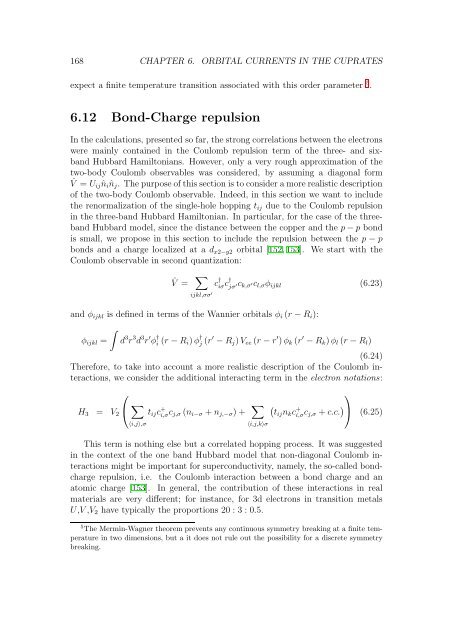pdf, 9 MiB - Infoscience - EPFL
pdf, 9 MiB - Infoscience - EPFL
pdf, 9 MiB - Infoscience - EPFL
Create successful ePaper yourself
Turn your PDF publications into a flip-book with our unique Google optimized e-Paper software.
168 CHAPTER 6. ORBITAL CURRENTS IN THE CUPRATES<br />
expect a finite temperature transition associated with this order parameter 5 .<br />
6.12 Bond-Charge repulsion<br />
In the calculations, presented so far, the strong correlations between the electrons<br />
were mainly contained in the Coulomb repulsion term of the three- and sixband<br />
Hubbard Hamiltonians. However, only a very rough approximation of the<br />
two-body Coulomb observables was considered, by assuming a diagonal form<br />
ˆV = U ijˆn iˆn j . The purpose of this section is to consider a more realistic description<br />
of the two-body Coulomb observable. Indeed, in this section we want to include<br />
the renormalization of the single-hole hopping t ij due to the Coulomb repulsion<br />
in the three-band Hubbard Hamiltonian. In particular, for the case of the threeband<br />
Hubbard model, since the distance between the copper and the p − p bond<br />
is small, we propose in this section to include the repulsion between the p − p<br />
bonds and a charge localized at a d x2−y2 orbital [152, 153]. We start with the<br />
Coulomb observable in second quantization:<br />
ˆV =<br />
∑<br />
ijkl,σσ ′ c † iσ c† jσ ′ c k,σ ′c l,σ φ ijkl (6.23)<br />
and φ ijkl is defined in terms of the Wannier orbitals φ i (r − R i ):<br />
∫<br />
φ ijkl = d 3 r 3 d 3 r ′ φ † i (r − R i) φ † j (r′ − R j ) V ee (r − r ′ ) φ k (r ′ − R k ) φ l (r − R l )<br />
(6.24)<br />
Therefore, to take into account a more realistic description of the Coulomb interactions,<br />
we consider the additional interacting term in the electron notations:<br />
H 3 = V 2<br />
⎛<br />
⎝ ∑<br />
〈i,j〉,σ<br />
t ij c + i,σ c j,σ (n i−σ + n j,−σ )+ ∑<br />
〈i,j,k〉σ<br />
⎞<br />
(<br />
tij n k c + i,σ c j,σ + c.c. ) ⎠ (6.25)<br />
This term is nothing else but a correlated hopping process. It was suggested<br />
in the context of the one band Hubbard model that non-diagonal Coulomb interactions<br />
might be important for superconductivity, namely, the so-called bondcharge<br />
repulsion, i.e. the Coulomb interaction between a bond charge and an<br />
atomic charge [153]. In general, the contribution of these interactions in real<br />
materials are very different; for instance, for 3d electrons in transition metals<br />
U,V ,V 2 have typically the proportions 20 : 3 : 0.5.<br />
5 The Mermin-Wagner theorem prevents any continuous symmetry breaking at a finite temperature<br />
in two dimensions, but a it does not rule out the possibility for a discrete symmetry<br />
breaking.
















